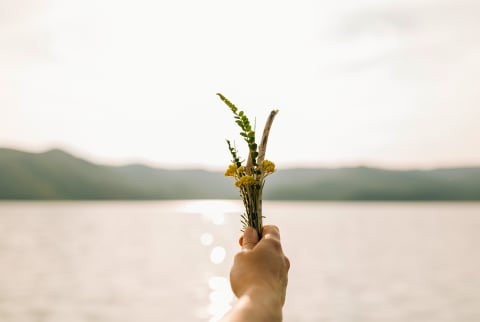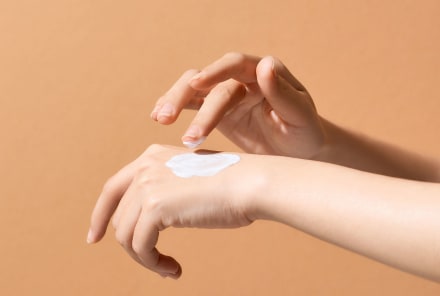Advertisement
How To Dry & Preserve Flowers: 5 Methods & Pro Tips


Flowers of all kinds add a sense of warmth to any room or occasion. While fresh flowers are an absolute pleasure, that pleasure is often short-lived! Dried flowers last longer, look stunning, and can make for a super-sustainable addition to your surroundings.
Here's what plant experts want you to know about drying and preserving flowers for your home or next special occasion.
How to dry & preserve flowers
The earliest known existence of dried flowers is during the time of the ancient Egyptians, who used dried flowers for fragrance, cosmetics, and ceremonial offerings left in tombs. The versatility of dried flowers hasn't changed in the centuries since.
"I enjoy the multiple uses I can get from dried flowers," northern Arizona master gardener and founder of Elevated Gardening Tina Gustafson tells mbg. Dried flowers can make for lovely additions to crafts, decor, treats, and herbal remedies. And since they last longer than fresh flowers, they tend to be more budget-friendly.
They're also low maintenance, so they're nice for people who love the idea of working with and having plants but aren't great at keeping up with watering cycles. Some couples also choose to use everlasting dried flowers as an alternative to fresh-cut flowers for their weddings.
Dried flowers make it easy to keep your favorite blooms around, which is especially nice when that bloom is no longer in season in your area. Considering that 80% of fresh-cut flowers available in the U.S. are still imported from faraway places like Colombia and Ecuador, drying flowers can also be a more sustainable option.
To sum up the benefits of dried flowers: They're beautiful. They're versatile. They're full of life, even without moisture. Botanical artist and founder of Copper and Moss Botanical Design Hannah Williams says it best: "Dried flowers are a captured moment that can last for many years to come."
Drying methods
If you're looking to dry your own flowers, there are many techniques you can use to do so. According to our plant experts, the time of year, where you are in the world, and your reason for preserving the flowers will determine which flowers you use and which drying method works best for you.
Every bloom is its own game and requires different levels of involvement, caution, and precision. However, a good rule of thumb is to find flowers when they're either partially or fully open, depending on the bloom and your reason for preserving.
Here's your introduction to a few of the most popular drying methods to play around with.
Method 1: Air drying
- Cut and prep your flowers for drying: Condition the flowers by cutting any extra greenery off the stems.
- Tie the stems into bundles: Using twine or string (or floss if the stems are delicate!), tie the flowers into bundles of a few flowers. You can also leave them as individual blooms.
- Hang them to dry: Hang the flower bundles or individual blooms onto a stick or a beam in a cool, dark room. Use hooks or a longer string to hang them. Make sure whatever room you use has air moving in and out of it, like a cracked open linen closet.
- Leave them alone for a while: Leave them hanging in that cool, dark space for one to two weeks, or longer, until they are fully dry. Hair spray can be used to maintain the shape of the petals, but it isn't necessary. Go sans hair spray and you'll still be left with perfectly dried blooms ready to use in a few weeks.
Method 2: Doing the "lazy method"
- Cut and prep your flowers for drying: Condition your flowers by removing any unwanted greenery, but keep the stems intact.
- Fill up a vase/bucket with a small amount of water: Fill a vase or bucket with a small amount of water in reference to the flowers you want to dry.
- Plop the flowers inside: Place your flowers into the vase or bucket, like you would with a fresh flower arrangement. The flowers will naturally dehydrate over the next two to three weeks as the water evaporates.
Method 3: Microwaving
- Cut and prep your flowers for drying: Condition the flowers by cutting the stems from the head of the flower. This drying method only requires the heads of the flower.
- Sandwich your flowers between two pieces of paper: Fold a piece of paper in half, hamburger style, and open it back up lying one side flat. Place the flower tops on the paper with enough space so they aren't touching before folding the other half on top.
- Fold that sandwich into a paper towel: Place the paper with your petals into a paper towel.
- Use a microwave-safe dish to press down on the flowers: Find a flat microwave-safe dish like the bottom of a glass or a brick, and place your flower sandwich underneath it.
- Microwave in short bursts: Microwave for 10- to 15-second bursts for as long as you need without scorching the blooms. How long your flowers take to dry will depend on the wattage of your microwave. It may take some trial and error to find what works for you.
Method 4: Using a flower press/heavy book
- Cut and prep your flowers for drying: Condition the flowers by removing any greenery you don't want. Flowers with thinner petals are great for pressing because they're more likely to retain their shape.
- Lay the blooms in between the press: Place your flowers flat on parchment or unbleached paper. Space them as closely as you'd like with enough room for them to dry.
- Let the press do its thing: Close the flower press and let your flowers dry. "When I am pressing a flower or foliage, I tend to leave them undisturbed for about two weeks to allow the moisture to completely dry out and as not to move any petals," Williams tells mbg. You can make your own flower press, like Williams' grandfather did for her, with wood, some cardboard, parchment paper, and bolts. You can also press flowers with a heavy book instead.
Method 5: Using a dehydrator
- Cut and prep your flowers for drying: Condition the flowers by removing everything except the flower heads. A dehydrator is great for drying edible flowers because it's quick and effective.
- Preheat the dehydrator: Set your dehydrator to somewhere between 95 and 110 degrees Fahrenheit. "Make sure you don't turn the heat up too high," says Gustafson, as it can denature some of the essential oils in the flowers.
- Space your flowers out: Space your flower heads out on the tray far enough apart that they don't overlap.
- Let your flowers dry: Check your flowers every 30 minutes to an hour to make sure they're drying properly. This whole process can take 4 hours to multiple days, says Gustafson, depending on the type of flower.
Tips to keep in mind
Pay close attention to how you condition the flowers before you dry them.
"Conditioning is generally quite simple and just means removing foliage from the stems," says Williams. It can also mean bunching the stems together, usually about two-thirds of the way down from the blooms.
Keep your flowers in cooler conditions
Keeping flowers in warm rooms can cause them to get moldy fast. "Normal room temperature is perfect," Williams tells mbg, but she recommends those starting out with drying flowers do so in a cool, dark room to be safe.
Remember there is no such thing as a "set time" to let flowers dry
Flowers are natural elements and require patience as they dry. "You just have to leave it to do its own thing," says Williams.
Make sure your flowers are dry before storing
Always check to see that your flowers are completely dry before you put them in any kind of storage container to prevent mold.
Dry in the sun only if you're OK with a bleached or faded look
Sometimes retaining the color of a bloom isn't something you're concerned about. In this case, instead of hanging the flowers to air dry in a cool, dark room, you can hang them somewhere they'll get some sun. Williams sometimes places blooms in her glasshouse to give them a bleached look.
Be careful when drying flowers you intend to eat
"Many flowers can be dried for crafts or decor, but there are much fewer edible flowers for teas and treats," says Gustafson. Do your homework and know which flowers you can actually eat before putting them on your plate.
If you opt for natural methods, stagger the drying timelines
The thing about nature is, you can't rush it if you want good results! "I try to plan ahead and think of other things I can do in the meantime," says Williams. "For me, that will include staggering drying so that I can start using a batch of dried florals while the next one is drying."
The takeaway
Drying flowers yourself can give you access to flowers with a long shelf life that you can use in wedding decor, art pieces, and more. But the real beauty of dried flowers? You get way more than you put in, and you get to work closely with Mother Nature herself.











